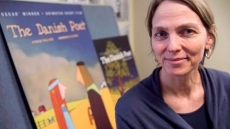VANCOUVER — He built it and they came — in droves — but it wasn't the original goal of George Grant Mackay who built the Capilano Suspension Bridge in the District of North Vancouver 126 years ago.
Mackay, a Scottish engineer and park commissioner for Vancouver, purchased 6,000 acres (2,428 hectares) of land for $1 an acre back in 1888. He kept 25 acres for himself and what is now the popular Capilano Suspension Park for his own use as a summer home.
"It was just his property — his backyard. The bridge was built simply because he wanted to get to the other side of his property," explained Samantha Bulmer, a media spokeswoman for the park.
"It took about a year to build and it was finished in 1889. The first bridge was built from hemp rope and cedar planks."
The bridge spans the Capilano River and is 140 metres long and 70 metres high.
Bulmer said the number of people drawn to the bridge prompted Mackay to get rid of it fairly quickly.
"He actually sold the park in 1892 simply because there were too many people traipsing through his backyard. The bridge became very, very popular, but it was never intended to be a tourist attraction when he first built it."
The new owner, Bruno Stelzer, saw its potential as a tourist attraction and charged visitors 10 cents to cross it. He commissioned engineer Harry Burgess to draw plans for a new wire bridge to replace the rope bridge.
The bridge has had a number of owners. The bridge in its current incarnation of steel cable and cedar planks was built at the request of Ray Mitchell in 1956. His family has owned it ever since.
Crossing the bridge is not for the faint of heart. Although relatively stable on a busy day, the number of visitors on it can cause it to jump and sway slightly.

"You do find the occasional person who is very, very scared. Some people have to try it a couple of times before they make it across," said Bulmer.
"We do have staff around that if people do need help they will help them get across. We try to encourage people to face their fears and if they need help we're there to help them."
The park expanded from just the bridge about a decade ago.
It now includes Treetops Adventures, consisting of seven footbridges suspended between old-growth Douglas fir trees on the west side of the canyon, forming a walkway up to 30 metres above the forest floor.
The park also features rainforest ecotours, gardens, nature trails, North America's largest private collection of First Nations totem poles, period decor and costumes, and exhibits highlighting the park's history and the surrounding temperate rainforest.
"When George MacKay first sectioned off that land he also was the person to set aside the land for Stanley Park. A lot of his land was purposely set aside for recreation to preserve the natural beauty," said Bulmer.
"With our current owners we are going back to the trends of wanting to keep it for its natural beauty."
The park can attract up to 6,000 visitors on a busy day and about 800,000 a year.




